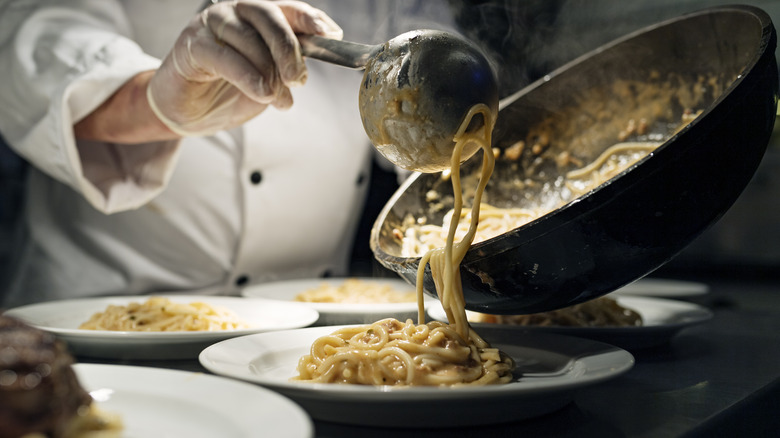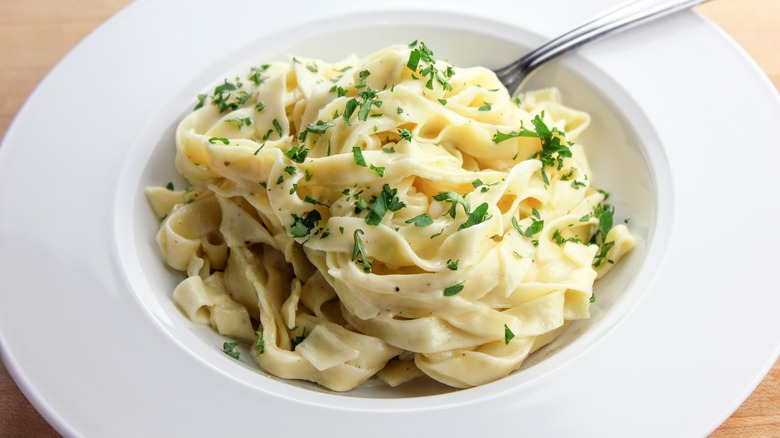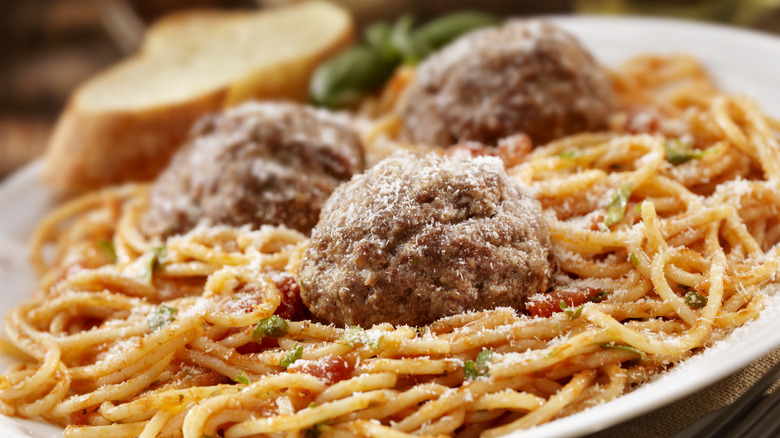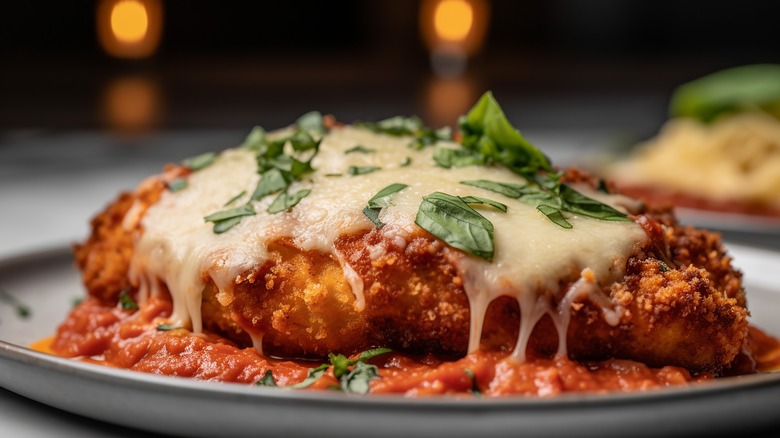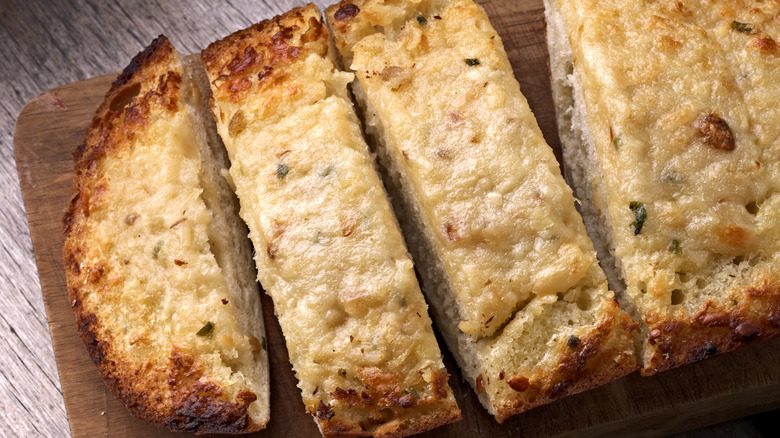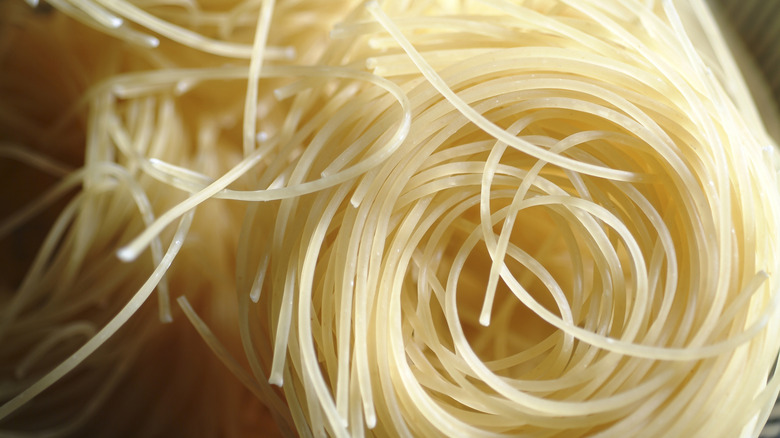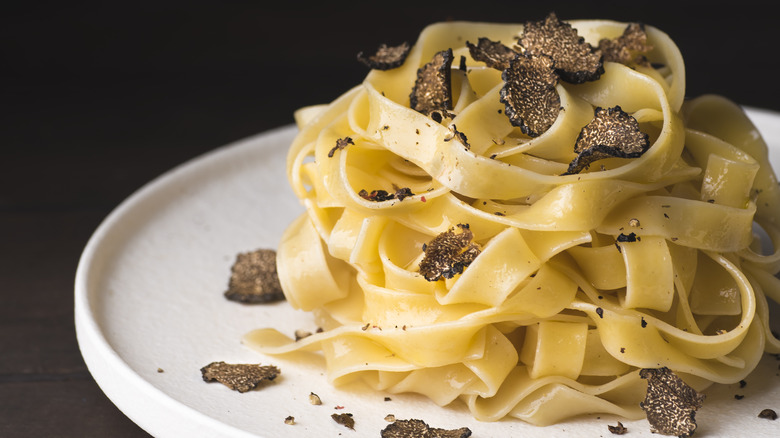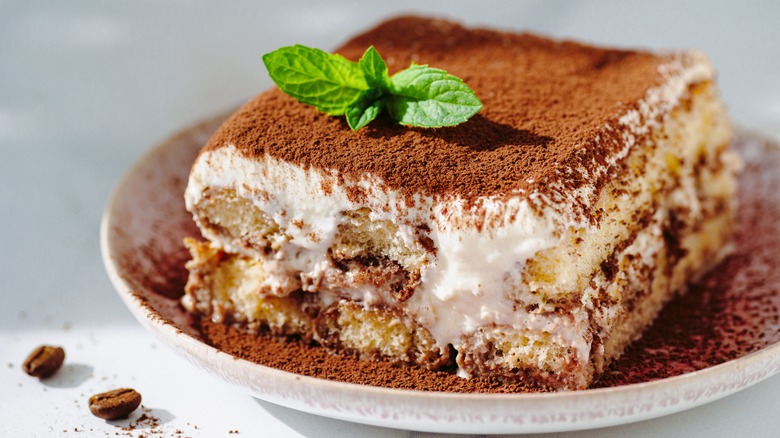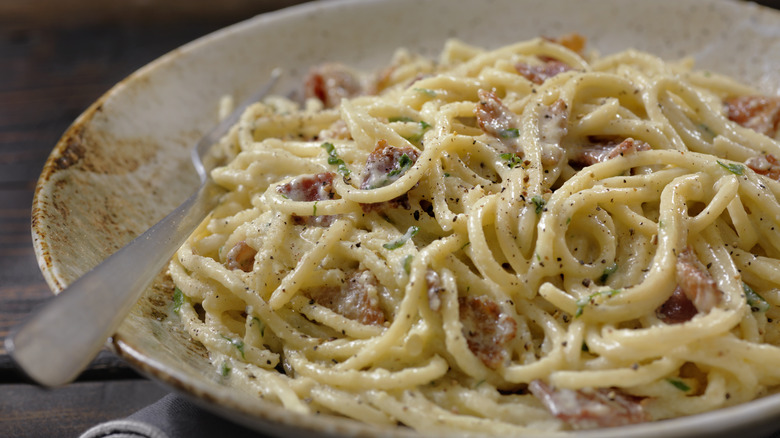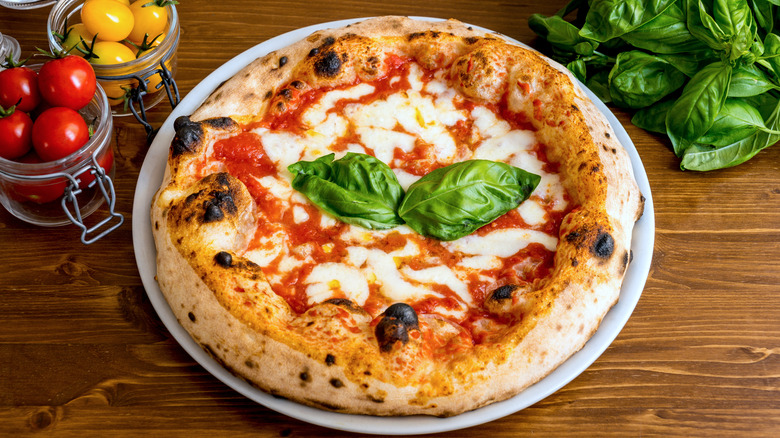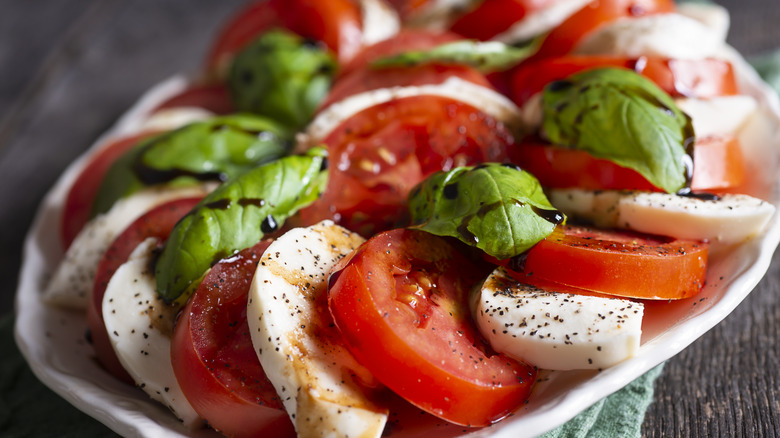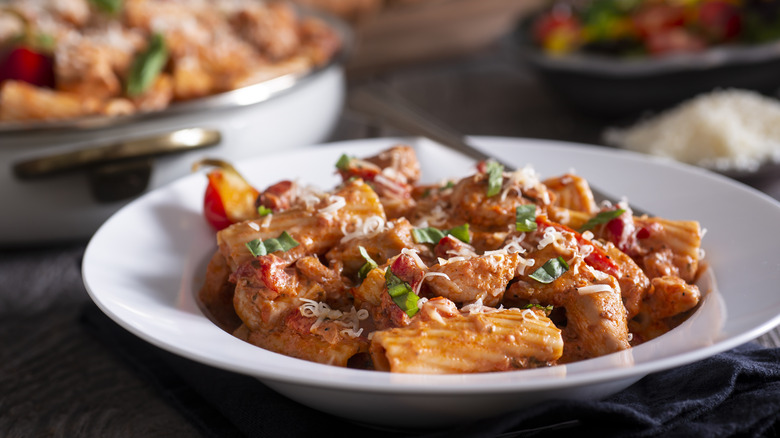10 Things You Should Think Twice Before Ordering At An Italian Restaurant
When it comes to eating out, you can never go wrong with an Italian restaurant. Whether you decide to hit up a beloved chain or visit your go-to local favorite, there's always something every member of your group will enjoy, regardless of taste preferences or dietary restrictions. That's because Italian cuisine is some of the most beloved food in the world. Considered comfort food by many, Italian dishes are beloved for their fresh, seasonal ingredients and simple recipes. Italian cuisine also varies by region, offering extensive options, ranging from pasta to meat to seafood, that will please any palate.
Unfortunately, not every restaurant, especially in the U.S., will get every menu item right. It's a common practice to cut corners on some dishes, especially when it's a matter of saving money. Here in the States, many Italian restaurants favor Americanized Italian food over authentic dishes. While there's nothing wrong with Italian-American cuisine, it's important to look out for dishes that may not be worth your money or that you can easily make at home for a fraction of the cost.
Though reputable restaurants that prioritize fresh, authentic ingredients likely won't fall victim to these menu item pitfalls, be aware of these classic dishes that may skip out on quality ingredients and the rich tradition of Italian cooking. Order with awareness to ensure you enjoy your meal that much more.
Fettuccine Alfredo
When you think of deliciously rich, cream-based pasta that goes beyond the red sauce norm, what comes to mind first? It's likely fettuccine Alfredo and for good reason. The dish has a long history as a go-to comfort food. In 1914, Roman restaurant owner Alfredo Di Lelio decided to make his then-pregnant wife a simple pasta dish that wouldn't aggravate her morning sickness. He threw together some fettuccine with a bit of butter and Parmigiano Reggiano to create what he called pasta in Bianco or "white pasta." His wife loved it so much that De Lelio made his sauce a menu staple that eventually made its way to the U.S. and took off as the lovingly named Alfredo sauce.
Since then, we've taken Di Lelio's simple sauce and added heavy cream, milk, and other ingredients, like chicken or shrimp. But the fact remains — fettuccine Alfredo, at its heart, is an incredibly easy-to-make dish. As a result, it's not worth your money when compared to other dishes at Italian restaurants. Chef Raffaele Dall'Erta, executive chef at Hamptons Restaurant, goes so far as to tell Business Insider that fettuccine Alfredo is a "lazy pasta dish" and can easily be made at home to taste even better than it does at a restaurant. For a better alternative, try ravioli in a cream sauce for a rich, flavorful dish made with a white sauce.
Spaghetti with meatballs
Spaghetti with meatballs is as ubiquitous in Italian-American cuisine as pizza, but is it the best thing to order on a restaurant menu? Probably not. First and foremost, it's important to remember that spaghetti with meatballs is a wholly American invention, so if you're looking for an authentic dish that you'd also find in Italy, you won't find it here. Spaghetti with meatballs likely first appeared in the U.S. during the late 19th century when a wave of Italian immigrants from the south of Italy made their way to the country. Because food was more affordable in the U.S., delicacies like meat became staples in the Italian diet, and the once humble meat sauce became pasta accompanied by the large meatballs we know and love today.
Because spaghetti with meatballs is so overdone in Italian-American cuisine, the popular restaurant item is one of the first dishes with which restaurants may cut corners. While not all restaurants do this, some may make their meatballs ahead of time, and then reheat them once ordered, making for a less-than-fresh taste. Tomato sauce is also typically pre-made ahead of time, and reheated many times throughout the night to accommodate different orders and dishes. If this doesn't bother you, plunge in and enjoy, but if you want something a little fresher, try making spaghetti and meatballs at home. This way, you can customize the dish to fit your preferences.
Chicken Parmesan
Much like spaghetti with meatballs, chicken parmesan is a beloved comfort food on many Italian restaurant menus in the U.S., but it is a mostly American creation. Its origins can likely be traced back to the same time as spaghetti with meatballs when Italian immigrants experimented with their cuisine based on what they could afford. Chicken parmesan likely evolved from parmigiana di melanzane, or eggplant parmesan, a dish featuring battered and fried eggplant covered in tomato sauce and cheese. When meat was more accessible, chicken replaced eggplant in the dish we are now most familiar with.
But as delicious as the gooey-cheesy chicken doused in tomato sauce can be, it's another menu item that may not be worth it. Popular chain restaurants like the Olive Garden pack chicken parmesan with nearly 3,000 milligrams of sodium, significantly more than the FDA's recommended daily allowance of 2,300 milligrams. Other restaurants tend to cut corners when making this dish, often making their chicken parmesan from frozen chicken that's deep fried, then smothered in sauce and cheese to hide the frozen flavor. If you want a similar delicious chicken meal, a better alternative would be chicken Milanese, a battered and fried chicken cutlet often served with lemon or a side of arugula salad.
Garlic bread
If garlic bread is offered complimentary to your meal, there's no harm in enjoying it with the dishes you order. However, going out of your way to pay for garlic bread can often be a misstep, both financially and flavor-wise. Firstly, if it matters to you, bread in Italy is not typically served with loads of garlic, cheese, or butter as we have it in the States, which makes our version a less-than-authentic menu item. Garlic bread, as we know it, is an American invention, inspired by Italian ingredients to suit the American palate. That being said, garlic bread is also a crafty way for restaurants to use cheese, garlic, and other ingredients to hide the fact that the bread is no longer fresh.
Chef Gianluca Guglielmi, Executive Chef of Donato & Co. in Berkley, California tells Chowhound that the correct and most authentic way to make garlic bread is fett'unta, "a simple slice of bread brushed with fresh garlic and drizzled with cold pressed extra virgin olive oil, then sprinkled with freshly ground black pepper." There is no butter, parsley, chunks of garlic or Parmesan, he adds, especially since Italians prefer to use the D.O.P.-certified Parmigiano Reggiano.
Angel hair pasta
All pasta shapes and textures have their place in Italian cuisine, but among the most tricky is Cappellini, better known as angel hair pasta. Like strands of hair from which it gets its name, angel hair pasta is incredibly fine and long, like spaghetti's thinner cousin. As a result, it's an incredibly delicate pasta that is often best suited for light summer sauces that do not weigh down its fine strands.
Because angel hair is so finicky during the cooking process, it may be best to stay clear of ordering it if you're allowed to choose a pasta shape. Even if the chef gets the cooking time right so the pasta is not overcooked — a fine art that chain restaurants might not always master — there's a chance you'll still get soggy noodles by the time your dish hits the table. That's because the pasta will continue to cook in the hot sauce. While with most pasta, you typically won't notice if the sauce has cooked the pasta a tiny bit more, angel hair is always a few seconds away from being overcooked thanks to its delicate structure. If you're opting for a heavy sauce like a bolognese or a cream sauce, choose a wider pasta shape, like a pappardelle or linguine. These shapes are better suited to hold more sauce with each bite, packing a greater flavor punch than angel hair.
Truffle pasta in a cream sauce
Sorry to burst your bubble, but the much-loved truffle pasta that feels elegant and rich in flavor isn't always what it's cracked up to be. That's because truffle-rich dishes, especially those made with a cream sauce, don't typically feature fresh, real truffles. Instead, restaurants have a variety of substitutes that are more affordable and passable enough for most palettes to use in place of the real stuff.
Chef Brandon Boudet, Executive Chef and Co-Owner of Little Dom's in Los Angeles, California tells Chowhound that there are a host of other things that might wind up in your pasta aside from fresh white or black truffles. "Stay clear of truffle oil, pieces, dried truffles, [or] truffle salt, as these have likely been enhanced with chemicals or other ingredients that alter the flavor — this ultimately does not taste like a real, fresh truffle," he says. Cream sauce, which is already rich in flavor, can further meld with these substitutes and hide the artificial flavors better. Fresh truffles, he adds, are easy enough for restaurants to source that this shouldn't be an issue. If a restaurant is willing to grade the truffle fresh onto your pasta in front of you, that's a good sign that what you're getting are the freshest ingredients.
Tiramisu
Unlike many menu items on this list, tiramisu, the popular dessert made with coffee and a dusting of cocoa powder is actually a direct export from Italy. Its origins are a bit contested, with a popular restaurant called Le Beccherie in the region of Veneto claiming it was created there first in the 1970s, while others claim a handwritten recipe from 1959 is the true origin of the dish. But no matter where or when it came from, tiramisu hit the Italian dining scene in a big way in New York in 1985 and has become a staple dessert ever since.
So why shouldn't you order it? That really depends on the reputation of the restaurant. If you're sure that the restaurant you're going to pride itself on fresh, authentic ingredients, you can be confident the tiramisu landing on your table is the most delicious it can be. According to Chef Gianluca, however, many Italian American restaurants will cut corners with ingredients for tiramisu, which takes away from the creamy, rich flavor you're hoping for. "This popular dessert is often made with cream cheese and/or sour cream, unpasteurized eggs, ladyfingers, and regular drip coffee," which Chef Gianluca notes, isn't correct. "Real Italian tiramisu is made with mascarpone cheese, espresso coffee, and pan di Spagna — a fluffy Italian sponge cake." There are many other Italian desserts worth trying if you want to expand your palette. Tiramisu is also easy to make at home with the right ingredients.
Spaghetti alla carbonara
If you're craving carbonara for dinner, take a second to consider whether the restaurant you're about to go to can prepare a fresh and flavorful dish of pasta instead of a heavy mass of cream that will sit in your stomach. While how it's prepared is a matter of whether or not the chef sticks to the original, Italian recipe, it's important to remember that carbonara likely came from a request to accommodate the American palate in the first place. The most commonly accepted origin story of carbonara dates back to World War 2, when Roman restaurant owners sought to please American soldiers stationed in Italy with a pasta that combined popular American breakfast foods — eggs and bacon — with what they had on hand.
Since the dish made its way to the States, we've found ways to customize it even further, for better or for worse. Chef Gianluca therefore cautions against ordering it if you know the ingredients are artificial or preserved. "Many Carbonara recipes are made with manufactured cream, fake Parmesan cheese, and bacon," he says. "The real Italian Carbonara is made with guanciale, which is cured pork jowl, egg yolk, Pecorino Romano, and a superior quality black pepper." It's that simple, and that's why it's also an easy recipe to make at home.
Margherita pizza
Margherita pizza is, quite literally, the queen of all pizzas and guaranteed to be delicious no matter where you get it. So why did it make it onto this list? You may not get the most bang for your buck with this simple dish.
Like many pizzas created in the pizza capital of Italy — Naples — the popular Margherita pizza has a rich, albeit somewhat mysterious history. Many believe that in 1889, Queen Margherita of Savoy decided to visit a pizza maker named Rafaelle Esposito in Naples to try something new. Although the Margherita pizza as we know it had already existed since 1830, Esposito elected to make this pizza for the queen because it had all the colors of the Italian flag — red, green, and white. The queen loved the pizza so much that she decided it should be named after her, and a plaque at the still-standing Pizzeria Brandi where this all took place commemorates that event.
Now, every Italian restaurant worth its weight will feature Margherita pizza, but it may be time to try something different. Chef and restaurant Julia Helton tells Business Insider that typically Margherita pizza comes with a huge markup which doesn't make it worth the cost. The ingredients of mozzarella, tomato sauce, basil, and pizza dough typically cost about $1 for restaurants to source, she says, making the $12-ish price tag not worth your money. Instead, opt for more elevated add-ons, like capicola and hot honey for a spicy kick.
Caprese salad
A platter of mozzarella, basil, and tomato masquerading as a "salad" can never be wrong, right? The answer depends on the season in which you decide to order it.
Caprese salad gets its name from Capri, the area where it was likely first created. While its origins are contested, many love Caprese for its fresh flavors, including summer-ripened tomatoes, basil, juicy mozzarella, and a dash of extra virgin olive oil. It's also seen as a patriotic dish for Italy, since, much like the Margherita pizza, all ingredients, when put together, resemble the Italian flag.
But as delicious as Caprese is, whether it be in a salad or a sandwich, the dish's tastiness is tied to its seasonality. If you're ordering Caprese salad, or any tomato-based dish like it, outside of the summer months, you're not going to get the most ripe, flavorful tomatoes around. "Many of these salads are on the menu year-round and feature ordinary mozzarella and tasteless tomatoes," Chef Gianluca says. "A great Caprese should be ordered only in the summertime, preferably made with good heirloom tomatoes, imported buffalo mozzarella, fresh basil, cold pressed extra virgin olive oil, and Sicilian sea salt." A house salad, featuring in-season veggies and greens, or a salad topped with burrata are great alternatives if you're craving something in the Caprese wheelhouse, but it's not summer yet.
Methodology
To choose the menu items on this list, we took a few things into careful consideration. First, we evaluated our personal experiences and lengthy history with Italian American cuisine to outline a list of potential menu items that were easy enough to make at home, not the best choice financially, or most likely to contain non-fresh ingredients. We also took into consideration whether a menu item was authentic to original Italian recipes, or whether it deviated drastically, and therefore wasn't a worthy choice if authenticity was being prioritized.
From there, we talked with two esteemed Italian American chefs, Chef Brandon Boudet and Chef Gianluca Guglielmi, for further insight into how these dishes are prepared and what the cost of making them typically is. We cross-referenced their recommendations of menu items to avoid with our original list, adding a bit of research from other publications with interviews featuring Italian American chefs, and compiled the final list featured here.
